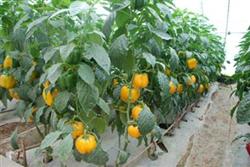Three techniques of fertilization of Capsicum in greenhouse
Pepper has a long growing period, but the root system is underdeveloped, the root amount is small, the soil is shallow, it is not tolerant to drought or waterlogging, and the ability to tolerate fertilizer is strong. Pepper is a vegetable type with more fertilizer absorption, which needs about 5.19kg of nitrogen, 1.07kg of phosphorus pentoxide and 6.46kg of potassium oxide for every 1000 kg. The amount of nitrogen, phosphorus, potassium and other nutrients absorbed varied in different growth stages. The amount of fertilizer absorbed from emergence to budding, early flowering, full flowering and maturity accounted for 5%, 11%, 34% and 50% of the total fertilizer requirement, respectively. The period from early flowering to full flowering is the period of vigorous vegetative growth and reproductive growth of pepper, and it is also the period of absorbing the most nutrients and nitrogen. From flowering to maturity, the vegetative growth of the plant is weak. At this time, the demand for phosphorus and potassium is the most. After mature fruit harvest, in order to promote the growth and development of branches and leaves in time, a large amount of nitrogen fertilizer is needed. According to the law of pepper fertilizer demand and the level of soil fertility, the trick of greenhouse pepper fertilization is to re-apply base fertilizer and skillfully apply topdressing, and the specific fertilization should follow the following principles: 1. Re-apply organic fertilizer. Apply more mature organic fertilizer (such as chicken manure). In the aged greenhouse, some enzyme bacteria fertilizer can be added to biological organic fertilizer. In greenhouses with serious soil-borne diseases (especially death), some Bacillus bio-organic fertilizers should be applied. two。 Rational selection of chemical fertilizer. When chemical fertilizer is used as base fertilizer, choose simple fertilizer as far as possible, such as urea, calcium superphosphate and potassium sulfate. When topdressing compound fertilizer, we should choose compound fertilizer containing nitrate nitrogen as far as possible. The application of true root in the period of seedling cultivation, transplanting and planting can shorten the slow seedling time and increase the resistance of pepper seedlings to adverse environment. Pepper has the advantages of continuous fruit-setting ability, less falling flowers, high yield and improved quality. 3. Rational distribution of the proportion of base fertilizer and topdressing fertilizer. In general, organic fertilizer, micro fertilizer, 80% phosphate fertilizer, 50% potassium fertilizer and 30% nitrogen fertilizer are mixed and used as base fertilizer, and the remaining 70% nitrogen fertilizer, 20% phosphate fertilizer and 50% potash fertilizer are used as topdressing respectively. Some trace elements such as borax can be foliar sprayed.
- Prev

Summer and Autumn Pepper Seedling Raising Techniques
Colored pepper is named for its colorful color of red, yellow, white, green, purple and black. Local vegetable farmers call it "colorful pepper,""colorful pepper" or colored sweet pepper. It can be eaten raw, cooked and with vegetables, but also pickled sauce system, yield and economic benefits are ten...
- Next

High-yield Management techniques of Chinese Cabbage
High-yield Management techniques of Chinese Cabbage
Related
- Where is it suitable to grow horseradish in China? it is expected to see the middle altitude horseradish in Alishan.
- How to prevent tomato virus disease reasonably? (Control methods included)
- Many people like to plant towel gourd on the balcony. What are the main points of this method and management?
- What crops can chili peppers be mixed with?
- Fertilization techniques and matters needing attention in Tomato
- What are the grafting techniques for peach seedlings in spring?
- Harm and control methods of root swelling disease of Chinese cabbage
- What are the pests of sweet potatoes? How to prevent and cure it?
- Symptoms, causes and Control methods of navel Rot in Tomato
- The cause of "Cucumber rotten bibcock" in Farmers' planting Cucumber and its Control Plan

